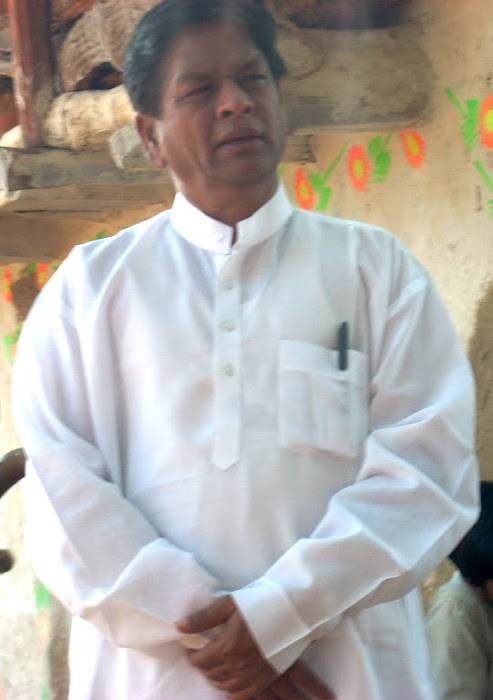Medieval
History
Chandela
Period : The Chandela Rajput clan ruled Bundelkhand from the 10th to the 16th
century. In the early 10th century they were Samant of the Pratiharas
of Kannauj,
and ruled from the fortress-city of Kalinjar.
A dynastic struggle among the Pratiharas from 912 to 914 allowed the Chandelas
and other feudatories to assert their independence. Chandela kingdom is
believed to have derived its popular name, 'Jejabhukti’; `jeja’ is
believed to be a corruption of `yagna’ and `bhukti’ was a term for province
since Gupta times. The Chandelas captured the strategic
fortress of Gwalior
c. 950. Dhanga (c. 950-1008) left many inscriptions, and endowed a large number
of Jain
and Hindu
temples. Dhanga's grandson Vidyadhara (1017-29) expanded the Chandela kingdom
to its greatest extent, extending the Chandela dominions to the Chambal
river in the northwest and south to the Narmada River.The original seat of
the clan is believed to have been Maniyagarh, a large ruined fort on the banks
of the Ken in Chhatarpur district. Their tutelary deity was called Manya Deo.
Later, the Chandelas made Mahoba their capital.
Khajuraho : Chandelas built
the famous temple-city of Khajuraho between the mid-10th and mid-11th century. Chandela tanks
invariably adjoined the temples. From the absence of canals, one can surmise
that were primarily meant to gain spiritual boons than provide surface
irrigation. The Chandelas were also great temple builders. Yashovarman is
believed to have initiated the construction of one of the large Vishnu temples
in Khajurao
(Chhatarpur), the Lakshman temple.
Parmal : From 1008 AD onwards Mahmud of Ghazni
launched attacks to northwestern
Prithviraj
Chauhan was himself defeated and killed by Muhamad Ghor in 1192, and ten years
later Kalinjar fell to the Turkish Muslims, who destroyed the temples on the
fort and converted them to mosques, and proceeded to do the same in Mahoba. In
the 14th century, a large part of
Khangars :
In
the 19th century, the British listed The Khangars as one of the tribal groups
of Bundelkhand. The Khangars themselves claimed Rajput descent. According to
the Khangar folk tradition, a Khangar warrior, Khet Singh, fought along with
Prithviraj Chauhan in the war against the Chandela king Parmal, and was awarded
part of the defeated king’s territory. Khet Singh is believed to have made his
capital in a massive seven-storied fort in Tikamgarh district, Garh Kundar. (By
another version, the fort was built by the Chandelas).
Early
Bundelas : We
know little about the Khangar 'kingdom' for over the next hundred years, till
the emergence of a Bundela chief, Sohanpal. The founder of the
clan is said to be one Pancham , son of a king of
One of
Pancham's three sons, Sohanpal, is believed to have wrested Garh Kundar from
the Khangars in the middle of the 13th century AD. (His version is entirely
denied by revivalist Khangars who state that the Khangars ruled over Garh
Kundar till 1347, when they were vanquished by Mohammed Tughlaq, and all their
women committed 'jauhar' by jumping into a well, which can be seen in the fort
even today).
Bundelas
& Mughals : In
the 16th century when a Bundela chief called Rudra Pratap established base on the banks of the Betwa
in Orchha (literally 'hidden place'), near
Rudra
Pratap's grandson, Madhukar Sah increased the kingdom's territories, and
challenged Akbar's authority. When Akbar's son, Salim (later known as Jehangir ) rebelled, a son
of Madhukar Sah, Bir Singh, sided with Salim and arranged to kill Abul Fazl, a
high-ranking advisor of Akbar. When Salim alias Jahangir ascended the
While the
Bundela states occupied parts of Chhatarpur, Lalitpur,
Rani
Durgavati : In
the 14th and 15th centuries AD, there emerged in
In 1564, the
Garha Mandla queen Durgavati, who was of Chandela
origin, acting as a regent for her infant son, bravely met Mughal troops in
battle. Overpowered and finding her escape route cut off by rising waters of a
river, she is said to have killed herself. Rani Durgavati is one of the heroic
figures in this part of MP; a university is named after her in
Maharaj
Chhatrasal & Marathas : In the late 17th century, when Mughal power began to
wane, arose one of Bundelkhand's great historical figures: Maharaj
Chhatrasal, founder of an independent kingdom and a second line of
Bundela rulers. In his early life Chhatrasal did military service for the
Mughals in the
Chattrasal
made Panna the capital of his kingdom and bringing less powerful Bundela chiefs
under his banner, launched a series of successful assaults into Mughal
possessions, leading to the coining of a popular Bundeli saying:
It
Jamuna ut
Chhatrasal so laran ki, rahi
na kahu hons
(From the
Jamuna to the
However, as
he expanded his territory into the district of Jhansi, the Mughal governor of
Allahabad, Muhammed Khan Bangash, counter attacked with great force, compelling
Chhatrasal to seek help from the other great power of the time, the Marathas,
led by Peshwa Baji Rao in Pune. Chhatrasal written a letter to Peshwa with
following
"Jo gati bhai Gajendra ki, So gati pahunchi
aay
Baaji jaat Bendel ki, Raakho Baajirai”
Maratha
armies helped the Bundelas deliver a humbling defeat to Bangash in 1729 and
before he died two years later, Chhatrasal conferred a third of his kingdom to
the Peshwa. Of what remained, he divided it among his numerous sons, relatives
and loyal chiefs. Thus arose Bundela-ruled states of Panna, Jaitpur, Ajaigarh
and Charkhari, and several smaller estates.
To stake
claim over the territory granted to him by Maharaj
Chhatrasal, the Peshwa of Pune appointed a governor in





